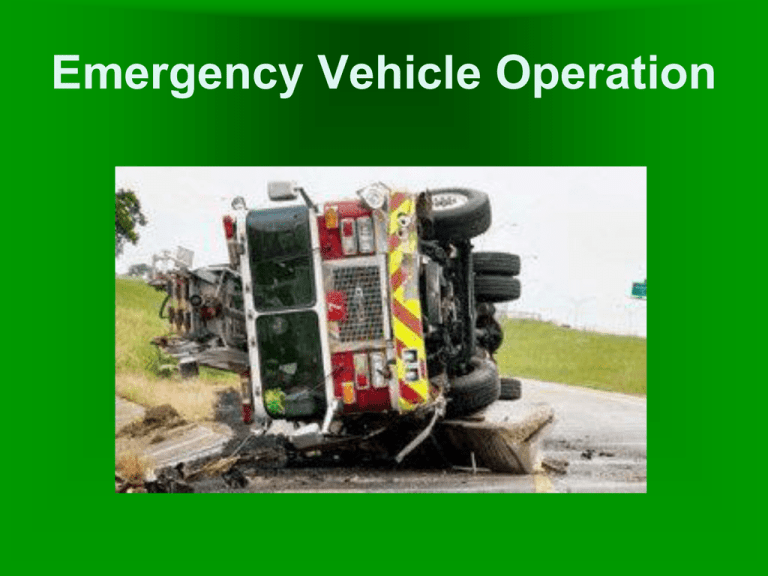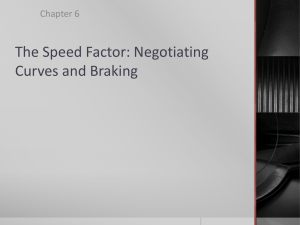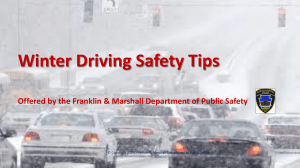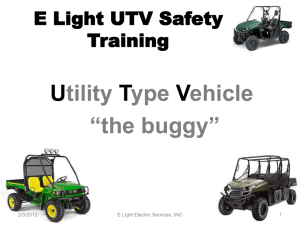Emergency-Vehicle-Operation-6-12-08
advertisement

Emergency Vehicle Operation Emergency Vehicle Operation Objectives List five common causes of fire apparatus collisions. Name the regulatory agency that governs emergency apparatus operators. Identify national standards addressing the emergency vehicle operator. Research your departmental policies and procedures for emergency vehicle operators. Discuss the importance of a driver’s ATTITUDE. Defensive driving techniques. Auxiliary braking systems. Emergency Vehicle Operation Fire Apparatus Collisions Many might think that accidents happen more often during adverse weather conditions or at night. According to studies made in the early 1990’s quite the opposite was found to be true. Collisions are most likely to occur during ideal vision and road conditions. Fire apparatus collisions can be grouped into five basic causes. Fire Apparatus Collisions Top five causes: 1) Improper braking of the apparatus!! Seems we have seen this somewhere else. 2) Reckless driving by the public. 3) Excessive speed by the apparatus operator. 4) Lack of driving skill and experience. 5) Poor apparatus design and maintenance. Fire Apparatus Collisions NFPA statistics compiled annually show that, historically, 20-25% of all firefighter injuries and deaths in the U.S. are caused by vehicle collisions while responding to or returning from emergency calls. From October 2001 to December 2007 twenty-nine Texas firefighters died in the line of duty. Of that 29 seven died in motor vehicle accidents. This equates to about 24% of the deaths being caused by MVA’s. Regulatory Agency The Texas Department of Public Safety governs emergency vehicle response. • • • • • • SECTION 546.001. PERMISSIBLE CONDUCT SECTION 546.002. WHEN CONDUCT PERMISSIBLE SECTION 546.003. AUDIBLE OR VISUAL SIGNALS REQUIRED SECTION 546.004. EXCEPTIONS TO SIGNAL REQUIREMENT SECTION 546.005. DUTY OF CARE SECTION 546.006. DESIGNATED EMERGENCY VEHICLE DURING DECLARED DISASTERS • SECTION 546.021. MUTUAL AID ORGANIZATIONS Emergency Vehicle Operation National Standards NFPA 1002 - Standard for Fire Apparatus Driver / Operator Professional. This standard identifies the minimum job performance requirements for fire fighters who drive and operate fire apparatus, in both emergency and non-emergency situations. NFPA 1500 - Standard on Fire Department Occupational Safety and Health Program. This standard contains minimum requirements for a fire service–related occupational safety and health program. NFPA 1451- Standard for a Fire Service Vehicle Operations Training Program. This standard contains the minimum requirements for a fire service vehicle operations training program. This standard outlines the development of a written fire service vehicle training program, which includes the organizational procedures for training personnel, maintaining vehicles, and identifying equipment deficiencies; design; financing; and other areas. The knowledge and skills required of safety, training, maintenance, and administrative officers charged with developing and implementing the fire service vehicle operations training program is also outlined within this standard. These NFPA standards are available for purchase from www.nfpa.org. Emergency Vehicle Operation Departmental Research Each department has its own set of SOP’s that should clearly define your responsibilities as an apparatus operator. It is the Chief’s responsibility to see that each person allowed to drive fire department apparatus knows and adheres to the department’s policies. Driver Attitude The first lesson in learning to drive safely is to develop a safetyconscious attitude. Many experts would say this is the most important aspect of a safe driver. The safe and calm attitude of a fire apparatus operator should begin when they enter their POV to respond to the station for an alarm. This can be a very difficult task. There are several contributing factors to this difficult attitude adjustment. The personality traits of firefighters is to … help those in need, get there fast, and be first. The other contributing factor just makes these personality traits even more pronounced. The fact that most calls occur when we are not at the station means we are going to have an extended response time. So, what we do is drive faster to the station to make the first truck out. Then we drive fast to beat any other responding departments to the scene, so we can be first on. All these things snowball into a big adrenaline rush that we must control. I am not suggesting getting to the scene is not important, but we must do so calmly and safely! Defensive Driving Techniques Sound defensive driving skills are one of the most important aspects of safe driving. Each and every eligible member should be familiar with the basic concepts of defensive driving. Defensive driving techniques include … Anticipating other driver actions. Estimating visual lead time. Knowing braking and reaction times. Having knowledge of weight transfer. Combating skids. Emergency Vehicle Operation Anticipating Other Driver Actions Anticipation is the key to safe driving. Never assume what another driver’s actions will be. There are five control factors that we should always utilize: Aim high in steering: Find a safe path well ahead. Get the big picture: Stay back and see it all. Keep your eyes moving: Scan--do not stare. Leave yourself an “Out”: Do not expect other drivers to leave you an out (an escape route). Be prepared by expecting the unexpected. Make sure others can see and hear you: Use lights, air horns, and sirens in combination. Estimating Visual Lead Time When we talk about visual lead time we are referring the apparatus operator scanning far enough ahead, for the speed at which you are traveling, to ensure that evasive action can be taken if it becomes necessary. For example: If you are concentrating on traffic that is 100 feet in front of you, and based on the speed you are traveling it would take 200 feet for you to stop or perform an evasive maneuver, a collision is likely to occur. A good rule of thumb is to look ahead 12 seconds on city streets and 20 seconds ahead on highways. So, how do I know I am looking ahead 12 seconds? The way you determine how far ahead you are looking is … Pick a stationary object on the side of the road, such as a telephone pole, and begin counting. If you are wanting to look ahead 12 seconds, but it only takes you only 8 seconds to get to that stationary object, then you are not looking far enough ahead. Emergency Vehicle Operation Braking & Reaction Time Lets begin by defining a few terms. Reaction Time: Is the distance a vehicle travels while a driver is transferring their foot from the accelerator to the brake pedal after perceiving the need to stop. Braking Distance: Is the distance the vehicle travels from the time the brakes are applied until the apparatus comes to a complete stop. Total Stopping Distance: Is the sum the driver operator’s reaction distance and the vehicle braking distance. Factors that will influence your ability to stop . • condition and slope of the road • speed you are traveling • the weight of the apparatus (this is a huge factor, because many times we go from driving our POV that weighs 4000 lbs to driving an apparatus that may weigh 50,000 lbs in just a matter of minutes), • type of braking system and the condition Air Brakes So how do they work? We will KISS it, there are a few major components used in an air brake system … the air tanks, an air compressor mount to the motor, a very strong spring, and the brake pedal. The air tanks keep a reserve of air at pressures of 120 psi. The very strong spring is constantly trying to apply the brakes. Air pressure is used to keep the spring and brake pad compressed away from the brake rotor. What happens when you set the parking brake is, you are removing that air pressure, allowing for the spring to press the brake pad against the brake rotor. When you apply the brakes during driving you are compressing air in the lines, creating pressure which is turned into a mechanical action, which applies the brakes. Emergency Vehicle Operation Braking & Reaction Time Let’s look an illustration of stopping a standard sized engine, weighing around 30,000 lbs, traveling 35 MPH. Reaction Distance – 39 feet Braking Distance – 125 feet Total Stopping Distance – 164 feet This equals to just over half of a football field in length. Again, this is on dry flat pavement. Weight Transfer The Law of Inertia states “objects in motion tend to remain in motion; objects at rest tend to remain at rest unless acted upon by an outside force”. When an apparatus undergoes a change of direction, weight transfer takes place. The more severe the change the more severe the weight change. Water makes up much of the weight of our fire apparatus. It is also a moving weight. This is why the proper baffling of a water tank is so critical. A partially filled tank can also cause problems. This is because, though it is less weight, the water has much more room to move and gain momentum as it does, creating more Inertia. Combating Skids Training and learning to avoid conditions that lead to skidding is important. Learning to correct a skid once it occurs is just as important. Technology is helping us to combat the issue of braking. Most newer apparatus are equipped with all wheel antilock braking systems (ABS). This system minimizes the chance of a vehicle going into to a skid when the brakes are applied forcefully. How this works is … there is an onboard computer that monitors each wheel and controls the pressure to the brakes. Each wheel is equipped with a sensor that monitors the speed of each wheel. When a wheel begins to lock up, the sensing device sends a signal to the computer that wheel is not turning. The computer compares this signal with the signals from the other wheels to determine if they are still turning. If the computer determines the wheel should be turning, a signal is sent to that wheel reducing the brake pressure allowing the wheel to turn. All this takes place more than 20 times per second. Combating Skids When operating an apparatus without ABS and it goes into a skid, • release the brakes and allow the brakes to rotate freely • Turn the steering wheel in the direction of the skid. Once the skid is controllable, • gradually apply power to the wheels to further control the vehicle by giving traction. The only way for us to get better at controlling our apparatus in skid conditions is to actually train at a facility with a skid pad. These facilities are few and far between for large apparatus. Emergency Vehicle Operation Auxiliary Braking Systems There are several different types of auxiliary braking systems commonly found on fire apparatus. Engine Brakes Transmission Retarders Frictionless Braking Systems Apparatus can be equipped with more than one of these systems. Apparatus operators need to understand these systems so that they can be used properly; Their use should be avoided completely. When the road is WET!!! Emergency Vehicle Operation Auxiliary Braking Systems This chart shows the effectiveness of the different systems. Engine Brakes Engine brakes utilize the compression within the cylinders of the engine to create braking power. When pressure is released from the accelerator the engine brake is engaged. There are four steps to the operation of an engine brake. The principle behind the engine brake engine retarder is simple. In order to understand how the engine brake provides its strong retarding power, let's compare the engine cycles with and without an engine brake. The illustration pertains to a four-cycle engine. (1) The intake valve opens and air is forced into the cylinder by boost pressure from the turbocharger. (2) Air is compressed to approximately 500PSI by the engine piston. The energy required to compress this air is produced by the vehicle's driving wheels. Near top dead center, the engine brake opens the exhaust valves, venting the high pressure air and dissipating the stored energy through the exhaust system. (3) On the downward stroke, essentially no energy is returned to the piston (and to the driving wheels). There is a loss of energy. This loss is how the retarding work is done. (4) Normal exhaust stroke. Transmission Retarders This type of braking system can be referred to as “Braking Through Resistance”. Since most fire apparatus have Allison Transmissions we will look at their retarder. Allison’s hydraulic retarder is basically a vaned flywheel in the transmission housing. The transmission directs oil into the retarder housing to absorb the vehicle’s energy through the drive shaft. The absorbed energy is converted to heat and dissipated through the vehicle’s cooling system. Resistance to the flywheel, augmented by stators on the inside of the housing, delivers braking power to the driving wheels. More oil in the housing means stronger braking. Frictionless Braking Systems These systems utilize large electromagnets surrounding the drive shaft. Transmission Rotation Direction Direction Magnetic Field is Trying Rotate the Transmission Emergency Vehicle Operation Frictionless Braking Systems This is a picture of an electromagnetic braking system. Emergency Vehicle Operation Summary Learning to safely operate and handle our fire apparatus is the most important job we have as driver operators. There would be no reason to learn about pumping the apparatus if we can not get to the scene alive. I hope in the future we look into better ways to provide realistic, real world training of apparatus operators. Of all the things you can train on and buy to make your job safer, there is one device that works to save lives, and I want each of you to promise yourself today to commit to … WEARING YOUR SEATBELT!!!! Emergency Vehicle Operation Each member on this apparatus was wearing their seatbelt and walked away to spend more time with their families and fight fire another day!!!! Apparatus Positioning The Right spot at the Right time Page 92










